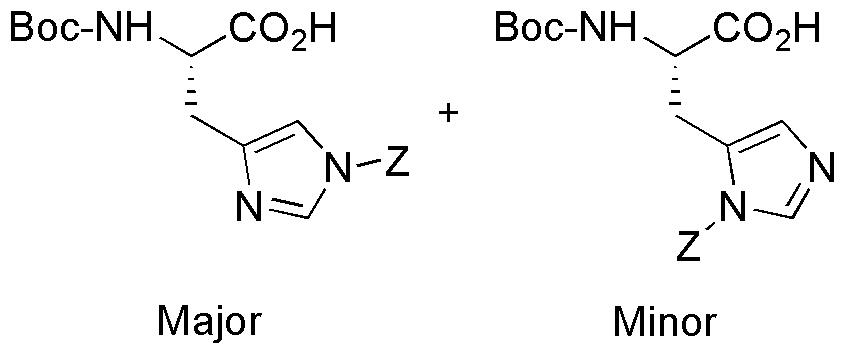Na-Boc-Nim-Z-L-histidine is widely utilized in research focused on:
- Peptide Synthesis: This compound serves as a protective group in the synthesis of peptides, allowing for selective reactions and improving yield. Its stability under various conditions makes it a preferred choice for researchers in organic chemistry.
- Drug Development: In pharmaceutical research, it is used to create histidine derivatives that can enhance drug efficacy. By modifying histidine, researchers can develop new therapeutic agents targeting specific diseases.
- Bioconjugation: The compound is valuable in bioconjugation processes, where it aids in attaching biomolecules to surfaces or other molecules. This application is crucial in developing targeted drug delivery systems.
- Protein Engineering: It plays a significant role in protein engineering, where it is used to modify histidine residues in proteins, improving their stability and functionality for various applications in biotechnology.
- Research in Catalysis: The compound is also explored in catalytic processes, particularly in asymmetric synthesis. Its unique structure can facilitate reactions that are essential in creating complex organic molecules.
General Information
Properties
Safety and Regulations
Applications
Na-Boc-Nim-Z-L-histidine is widely utilized in research focused on:
- Peptide Synthesis: This compound serves as a protective group in the synthesis of peptides, allowing for selective reactions and improving yield. Its stability under various conditions makes it a preferred choice for researchers in organic chemistry.
- Drug Development: In pharmaceutical research, it is used to create histidine derivatives that can enhance drug efficacy. By modifying histidine, researchers can develop new therapeutic agents targeting specific diseases.
- Bioconjugation: The compound is valuable in bioconjugation processes, where it aids in attaching biomolecules to surfaces or other molecules. This application is crucial in developing targeted drug delivery systems.
- Protein Engineering: It plays a significant role in protein engineering, where it is used to modify histidine residues in proteins, improving their stability and functionality for various applications in biotechnology.
- Research in Catalysis: The compound is also explored in catalytic processes, particularly in asymmetric synthesis. Its unique structure can facilitate reactions that are essential in creating complex organic molecules.
Documents
Safety Data Sheets (SDS)
The SDS provides comprehensive safety information on handling, storage, and disposal of the product.
Product Specification (PS)
The PS provides a comprehensive breakdown of the product’s properties, including chemical composition, physical state, purity, and storage requirements. It also details acceptable quality ranges and the product's intended applications.
Certificates of Analysis (COA)
Search for Certificates of Analysis (COA) by entering the products Lot Number. Lot and Batch Numbers can be found on a product’s label following the words ‘Lot’ or ‘Batch’.
*Catalog Number
*Lot Number
Certificates Of Origin (COO)
This COO confirms the country where the product was manufactured, and also details the materials and components used in it and whether it is derived from natural, synthetic, or other specific sources. This certificate may be required for customs, trade, and regulatory compliance.
*Catalog Number
*Lot Number
Safety Data Sheets (SDS)
The SDS provides comprehensive safety information on handling, storage, and disposal of the product.
DownloadProduct Specification (PS)
The PS provides a comprehensive breakdown of the product’s properties, including chemical composition, physical state, purity, and storage requirements. It also details acceptable quality ranges and the product's intended applications.
DownloadCertificates of Analysis (COA)
Search for Certificates of Analysis (COA) by entering the products Lot Number. Lot and Batch Numbers can be found on a product’s label following the words ‘Lot’ or ‘Batch’.
*Catalog Number
*Lot Number
Certificates Of Origin (COO)
This COO confirms the country where the product was manufactured, and also details the materials and components used in it and whether it is derived from natural, synthetic, or other specific sources. This certificate may be required for customs, trade, and regulatory compliance.

